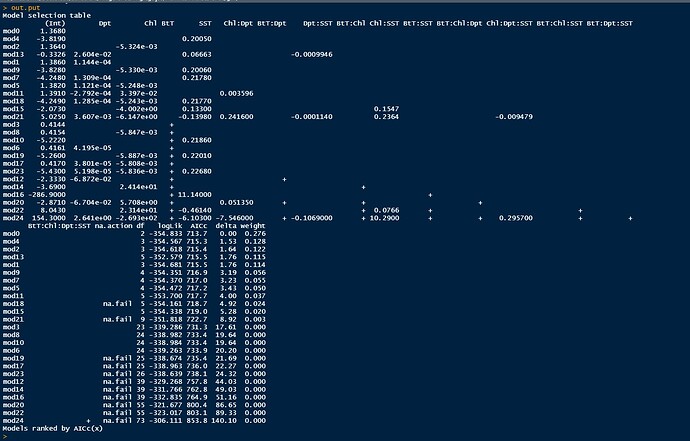I have 187 observations, the categorical variable is a predictor. My response variable is CPUE (catch per unit of effort). My goal is to know which of these variables (temperature, chlorophyll, depth, and bottom type) are most important for the capture of a specific species that I am analyzing. But I am struggling with this result where it appears that the null model is the most parsimonious. So I was wondering if is there a problem in adding a variable with so many levels to the model and why this (+) symbol is in the output always when the categorical variable appears. What does it mean? It also seems strange to me that no model with the categorical variable was never selected. This intuition of mine is also based on the response of a regression tree that I ran with this data and it appeared that the most explanatory variable was precisely the categorical variable that does not seem to have any relevance in the glm.
The categorical variable within the model it is a factor with 22 levels. I have searched and seen that the suggestion is to transform the levels into dummy variable but I don't think it is the way out once I would have to create 21 more columns and insert in the model... OBS: I already checked and the variable is a factor and not numeric.
mod0 <- glm(nCPUE ~ 1, data = bonaci, family=gaussian) #modelo nulo
mod1 <- glm(nCPUE ~ Depth, data = bonaci, family=gaussian) #depth
mod2 <- glm(nCPUE ~ Chlorophyll, data = bonaci, family=gaussian) #chlorophyll
mod3 <- glm(nCPUE ~ BottomType, data = bonaci, family=gaussian) #bottom type
mod4 <- glm(nCPUE ~ SST, data = bonaci, family=gaussian) #temperature
mod5 <- glm(nCPUE ~ Depth + Chlorophyll, data = bonaci, family=gaussian)
mod6 <- glm(nCPUE ~ Depth + BottomType, data = bonaci, family=gaussian)
mod7 <- glm(nCPUE ~ Depth + SST, data = bonaci, family=gaussian)
mod8 <- glm(nCPUE ~ Chlorophyll + BottomType, data = bonaci, family=gaussian)
mod9 <- glm(nCPUE ~ Chlorophyll + SST, data = bonaci, family=gaussian)
mod10 <- glm(nCPUE ~ BottomType + SST, data = bonaci, family=gaussian)
mod11 <- glm(nCPUE ~ Depth * Chlorophyll, data = bonaci, family=gaussian)
mod12 <- glm(nCPUE ~ Depth * BottomType, data = bonaci, family=gaussian, na.action = "na.fail")
mod13 <- glm(nCPUE ~ Depth * SST, data = bonaci, family=gaussian)
mod14 <- glm(nCPUE ~ Chlorophyll * BottomType, data = bonaci, family=gaussian, na.action = "na.fail")
mod15 <- glm(nCPUE ~ Chlorophyll * SST, data = bonaci, family=gaussian)
mod16 <- glm(nCPUE ~ BottomType * SST, data = bonaci, family=gaussian, na.action = "na.fail")
mod17 <- glm(nCPUE ~ Depth + Chlorophyll + BottomType, data = bonaci, family=gaussian, na.action = "na.fail")
mod18 <- glm(nCPUE ~ Depth + Chlorophyll + SST, data = bonaci, family=gaussian, na.action = "na.fail")
mod19 <- glm(nCPUE ~ Chlorophyll + BottomType + SST, data = bonaci, family=gaussian, na.action = "na.fail")
mod20 <- glm(nCPUE ~ Depth * Chlorophyll * BottomType, data = bonaci, family=gaussian, na.action = "na.fail")
mod21 <- glm(nCPUE ~ Depth * Chlorophyll * SST, data = bonaci, family=gaussian, na.action = "na.fail")
mod22 <- glm(nCPUE ~ Chlorophyll * BottomType * SST, data = bonaci, family=gaussian, na.action = "na.fail")
mod23 <- glm(nCPUE ~ Depth + Chlorophyll + BottomType + SST, data = bonaci, family=gaussian, na.action = "na.fail")
mod24 <- glm(nCPUE ~ Depth * Chlorophyll * BottomType * SST, data = bonaci, family=gaussian, na.action = "na.fail")
library(MuMIn)
out.put <-model.sel (mod0, mod1, mod2, mod3, mod4, mod5, mod6, mod7, mod8, mod9, mod10, mod11, mod12, mod13, mod14, mod15, mod16, mod17, mod18, mod19, mod20, mod21, mod22, mod23, mod24)
out.put
